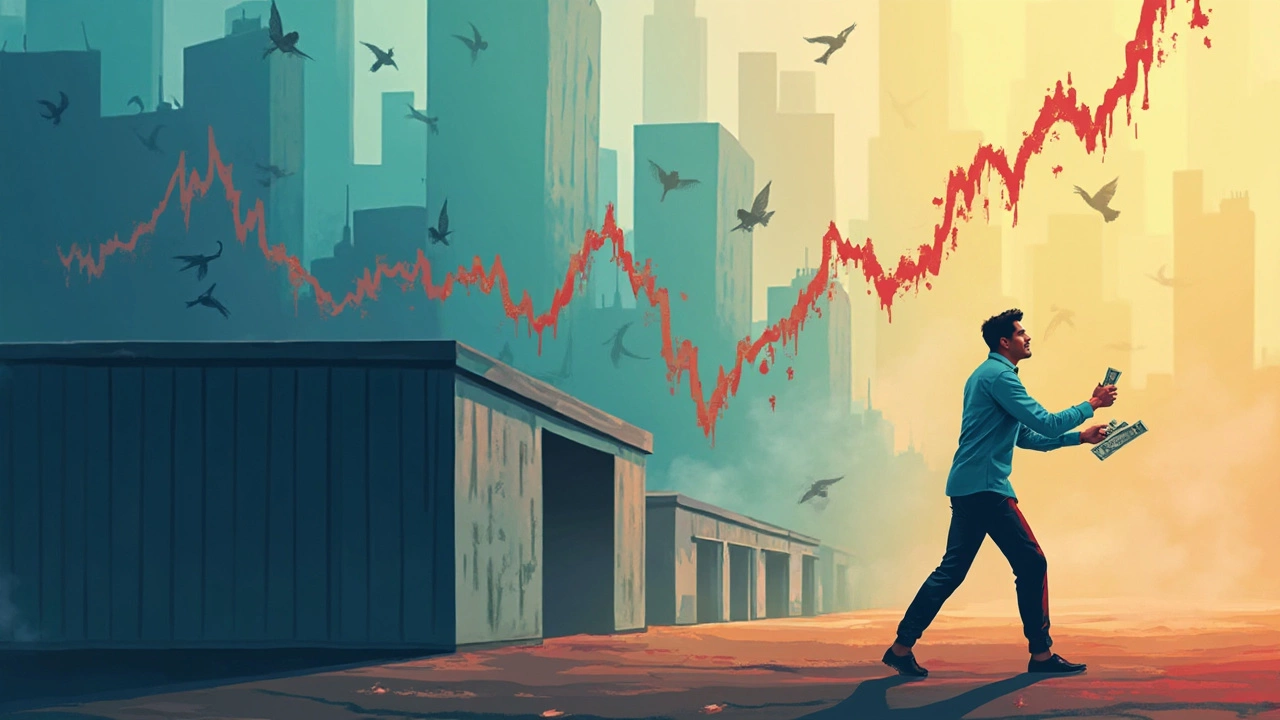Everyone is always talking about how commercial real estate is where the smart money goes. Office buildings, shopping centers, warehouses—you name it, people think it's a guaranteed win. But hang on. Commercial real estate isn’t the goldmine it's hyped up to be, especially these days. Inflation, remote work, and unpredictable market trends are shaking things up in ways investors rarely expect.
Take empty downtown offices since the pandemic. Even huge landlords lost rental income and had to offer deep discounts just to keep tenants from leaving. These vacancies aren’t rare—recent numbers from major cities worldwide show office occupancy rates hitting record lows. That means less income and, in many cases, dropping property values. You wouldn’t want to buy into a sinking ship, right?
If you're thinking of moving your money from stocks into commercial property, you really need to pause and ask why things feel riskier today than ever before. There’s more to it, too—managing these properties isn’t just about collecting checks. Extra costs, tenant headaches, and the struggle to sell fast all make people realize investing here isn’t nearly as easy—or as safe—as some make it sound.
- Unpredictable Market and Downturns
- Hidden and Rising Costs
- Tenant Troubles and Vacancy Risks
- Liquidity Nightmares
- When Commercial Real Estate Makes Sense—And When It Doesn't
Unpredictable Market and Downturns
Here’s the thing: the commercial real estate market moves in cycles, and those cycles can turn on you fast. Not that long ago, during 2020, commercial property values in cities like New York, London, and San Francisco dropped up to 20% almost overnight as offices emptied out. And we’re still feeling the effects. Vacancy rates for office buildings in major U.S. cities are stuck above 18%, higher than at any time since 1994. The market just isn’t bouncing back the way people hoped.
These aren’t just flukes caused by the pandemic, either. Whenever the economy dips, businesses start cutting back or closing locations, leaving landlords with empty spaces. That means no rent coming in, sometimes for months or even years. Retail spaces get hit especially hard when consumer habits change. Think about how many malls are now barely surviving as more people shop online. Warehouses might look safe now thanks to e-commerce, but if supply chains slow down or companies tighten their budgets, those spaces will hurt, too.
The trouble is, these risks are hard to predict and even harder to control. Investors who bought at the wrong point in the cycle often end up paying more than their property’s worth, and there isn’t a quick way to turn things around once the market sours. If you need to sell during a downturn, expect low offers and slow deals. That’s why putting your cash into commercial real estate can feel like riding a rollercoaster you can’t get off.
Hidden and Rising Costs
People often think that once they buy a commercial property, the big expenses are done. Honestly, the real costs start piling up after you sign on the dotted line. And they’re not small. According to CBRE’s 2024 market report, routine maintenance costs for older office and retail spaces jumped by over 17% in the last two years alone. If you’re budgeting for just the basics, you’ll get a rude awakening when that first surprise repair bill lands in your inbox.
Let’s break down some of these expenses so you know what you’re getting into:
- Commercial real estate often comes with sky-high property taxes, and these taxes can spike every year if your local government reassesses property values, which is happening more often in bigger cities.
- Insurance premiums are on the rise—especially for buildings in areas prone to floods, earthquakes, or even civil unrest. Some owners saw double-digit jumps in 2023 alone just to keep their basic coverage.
- Maintenance costs aren’t limited to a fresh coat of paint or fixing leaky pipes. HVAC replacements, elevator repairs, and complying with new building codes can drain your funds fast. A new commercial-grade HVAC system? That’s easily $20,000 or more.
- If your property sits empty for any stretch, you’ll still have to pay for utilities, security, and basic upkeep, so those bills don’t stop just because the rent isn’t coming in.
Then come the sneaky fees. Every time new rules pop up—think fire safety, accessibility, or environmental upgrades—you’re on the hook for the bill. In 2024, a bunch of cities started enforcing stricter energy efficiency standards, and owners now face thousands in retrofitting costs just to stay legal.
So if you’re hoping for easy cash flow, remember: the costs of owning commercial property aren’t just hidden—they’re always on the rise, and you need more than just rent payments to stay in the black.

Tenant Troubles and Vacancy Risks
If you think renting out your commercial property is as easy as putting up a sign, let’s talk reality. Finding a tenant is hard work, and keeping good ones can be even tougher. Since 2020, vacancy rates in major cities like San Francisco and New York have shot up, with some office spaces sitting empty for over a year. This isn’t just a local thing—vacancies hit record highs in 2023 across the US, with numbers hovering around 18% in many business districts. Shopping centers haven’t fared much better, especially with so many retailers going online.
Even when you land a tenant, it’s not all smooth sailing. Some tenants pay late or not at all, and chasing overdue rent drains time and money. And remember, every time a tenant leaves, you’re stuck with empty space. That’s money you’re missing each month. Your bills—like taxes, insurance, and maintenance—keep coming, whether the property is full or empty.
- Long vacancies can force you to drop rent prices just to get someone in the door. Lower rent means tighter profit margins.
- Commercial leases might run for years, but that also means if you get a bad tenant, you’re stuck with them and any problems they bring.
- Major businesses are shrinking office space thanks to remote work, so there’s less demand for big offices than ever before.
Worst case? If you need to evict a business, the process is slow and expensive. Plus, there’s a risk the business could damage your property or leave in the middle of the night. It all adds up to a lot more stress than most people expect when they hear about commercial real estate investing.
Liquidity Nightmares
Getting your cash out of commercial real estate isn’t like selling shares in Google. You can’t just click “sell” and have the money in your account the next day. It often takes months, and sometimes years, to actually close a deal. In 2023, the average time it took to close a commercial property sale in the US was nearly seven months—if the building even sold. That’s a lifetime if you need cash fast for an emergency or want to hop on another investment.
It gets worse during economic slowdowns. When interest rates go up or banks tighten lending, buyers vanish. Properties can sit empty on the market, gathering dust (and all the usual bills). In 2024, some cities saw commercial property listings spike 40% because so many owners were desperate to sell, but couldn’t find serious buyers.
If you think you can always “just rent it out” instead, remember this: vacancy rates for big office complexes stayed above 18% in most large US cities during 2023 and early 2024. No tenants means no cash flow—so you’re stuck paying property taxes, maintenance, and utilities out of pocket.
- Need money fast? Good luck. Selling takes time and there are no guarantees.
- You might have to offer huge discounts just to attract interested buyers.
- If your property is specialized (like a warehouse or lab space), expect even fewer buyers and longer wait times.
This lack of flexibility is what makes commercial real estate different from almost every other type of investment. If you value quick exits and easy cash, this market may leave you cold.

When Commercial Real Estate Makes Sense—And When It Doesn't
Sometimes, buying into commercial real estate has its place. Investors looking for steady rent income, especially from long-term, reliable tenants like government offices or large retail chains, might actually do alright. Some industrial properties—think warehouses and data centers—are doing well since e-commerce boomed. If you have experience, deep pockets, and a knack for dealing with complex paperwork and tenant issues, you might handle these risks better than the average person.
Bigger investors and REITs (real estate investment trusts) can diversify across cities, building types, and tenant types. That means they’re not betting the farm on one property or one kind of business staying hot. For regular folks though, most deals aren’t that flexible. Here’s what tips the scale for or against these investments:
- Commercial real estate makes sense when: you find a well-located building in a high-demand area (think logistics hubs), the tenants are stable, and you’re ready for a long-term commitment. Low lender interest rates can also sweeten the deal.
- It doesn’t make sense when: the area is showing empty storefronts, offices are moving remote, or retail is drying up. Also, if you need to sell fast, you’ll usually struggle—these properties often take months or even years to offload.
According to data from JLL and CBRE (two big names in property services), the national retail vacancy rate in early 2025 sat around 5.2%, while office vacancies in city centers jumped above 17%. Take a look at the table below for more context:
| Property Type | 2025 Vacancy Rate | Outlook |
|---|---|---|
| Office (Urban) | 17.3% | High risk |
| Retail | 5.2% | Stable (depends on location) |
| Industrial | 4.1% | Strong demand |
If you’re thinking of investing, ask yourself: is there a clear need for the space you’re buying? Is the neighborhood improving, or slipping? Can you wait years if the market turns cold? For most everyday folks, the headaches and risks usually outweigh the rewards—unless you’ve got some serious know-how or are ready for a long slog.
